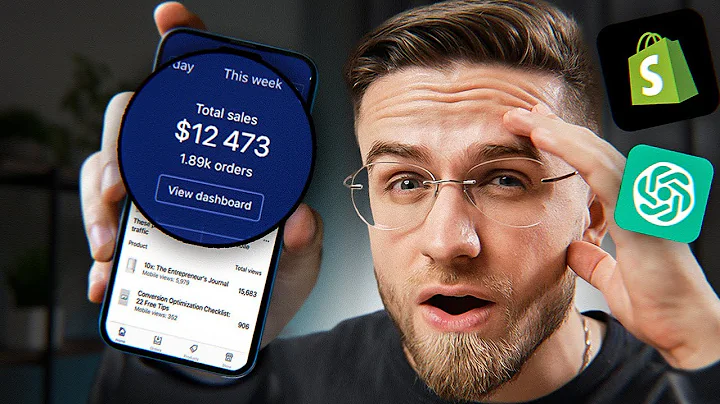Easy Guide to Installing Facebook Pixel on Shopify
Table of Contents:
- Introduction
- Setting up Metal Business Suite
- Adding Shopify Preferences
- Setting up Facebook Integration
- Connecting the Meta Business Account
- Managing Facebook and Instagram Data Sharing
- Creating a Facebook Pixel
- Connecting the Pixel to Chart Customer Behavior
- Reviewing the Channel Setup
- Running Ads on Facebook and Instagram
- Verifying the Store
- Managing Commerce Manager
- Tracking Conversions with the Events Manager
- Conclusion
Introduction:
Adding an actual pixel into the Shopify file process is a simple task if you have the Metal Business Suite enabled. This tool helps manage your best sensitivity from Facebook Messenger and Instagram in one place. By integrating your Shopify store with Facebook, you can track customer behavior, create marketing campaigns, and retarget ads. In this article, we will guide you step-by-step on how to set up the Metal Business Suite, connect your Shopify and Facebook accounts, and utilize the Facebook pixel for effective marketing strategies. So let's dive in and get started!
Setting up Metal Business Suite:
To begin, you need to enable the Metal Business Suite. This can be done by following these steps:
- Go to your Shopify admin dashboard.
- Navigate to the Preferences section.
- Locate the Social Sharing Image, Google Analytics, and Facebook Pixel options.
- Click on "Set up Facebook" to start the process.
- Sign in to your Facebook or Meta account.
- Connect your Facebook and Instagram accounts to Shopify.
- Choose the enhanced data sharing option.
- Save the settings.
By completing these steps, you will have successfully set up the Metal Business Suite for your Shopify store.
Adding Shopify Preferences:
Before proceeding with the Facebook integration, ensure that your Shopify preferences are properly set up. The following preferences are essential for seamless integration:
- Title and Meta Description: Optimize your store's meta tags for search engine visibility.
- Social Sharing Image: Choose an image that will be displayed when your store's URL is shared on social media platforms.
- Google Analytics: Connect your Google Analytics account to track website traffic and user behavior.
- Facebook Pixel: This is the main focus of our integration setup.
Now that you have configured your general Shopify preferences, let's move on to setting up the Facebook integration.
Setting up Facebook Integration:
To integrate Shopify with Facebook, follow these steps:
- Install the "Sales Channel" app from the Shopify App Store.
- Open the app and click on "Facebook and Instagram" to initiate the setup process.
- Sign in to your Facebook or Meta account.
- Follow the prompts to connect your account to Shopify.
- Agree to the terms and conditions.
- Submit your account for review.
Once your account is reviewed and approved, you can proceed to run ads on Facebook and Instagram. This integration will enable you to showcase and promote your products effectively.
Connecting the Meta Business Account:
After successfully completing the setup process, the next step is to connect your Meta Business account with Shopify. Here's how to do it:
- Open the Meta Business Suite.
- Access the Events Manager.
- Look for the Axio section.
- Find your Shopify clients.
- Connect the client to your Meta Business account.
Connecting your Meta Business account will allow you to manage your Facebook and Instagram data more efficiently.
Managing Facebook and Instagram Data Sharing:
Once your accounts are connected, you can manage the data sharing preferences for Facebook and Instagram. Follow these steps:
- Choose the enhanced data sharing option.
- Review the details of your Facebook and Instagram data sharing settings.
- Save the changes.
By selecting the enhanced data sharing option, you can maximize the benefits of data tracking and customer behavior analysis.
Creating a Facebook Pixel:
If you don't have an existing pixel, you can create one directly from the Facebook Events Manager. Here's how:
- Go to the Facebook Events Manager.
- Select "Create a Facebook Pixel."
- Configure the pixel settings as per your requirements.
- Copy the pixel code.
- Paste the pixel code into your Shopify store.
Creating a Facebook pixel is vital for tracking customer behavior and running effective marketing campaigns. With the pixel in place, you can gather valuable data for retargeting ads and optimizing your store's performance.
Connecting the Pixel to Chart Customer Behavior:
To ensure that the pixel is connected and tracking events correctly, follow these steps:
- Go to the Events Manager.
- Look for the Axio section.
- Find your Shopify event.
- Confirm that the event is set up correctly.
- Copy your store's website event URL.
- Paste the URL into the Events Manager's diagnosis section.
Verifying the correct setup of your pixel ensures accurate tracking of customer behavior and event data.
Reviewing the Channel Setup:
After setting up the pixel and verifying its functionality, you can review the channel setup. This step ensures that your shop is ready to run ads on Facebook and Instagram. Simply follow these steps:
- Navigate to your Shopify admin dashboard.
- Check if the shop is in progress on Facebook and Instagram.
- Ensure that all necessary sections are active in Shopify.
- Wait for the verification process to complete, which may take up to 48 hours.
Once your shop is verified and reviewed, you can proceed with creating and publishing products to maximize your online presence.
Running Ads on Facebook and Instagram:
With the integration complete and the pixel set up correctly, you can now run ads on Facebook and Instagram. Utilize the marketing potential of these platforms to promote your products effectively. By leveraging the Facebook pixel's data, you can target specific audiences and optimize your ad campaigns for maximum conversion.
Verifying the Store:
Verify that your Shopify store is functioning correctly to ensure a seamless user experience. This includes reviewing the shop catalog, ads, and other details. The Commerce Manager allows you to oversee and manage various aspects of your store, such as inventory, financials, and performance.
Tracking Conversions with the Events Manager:
The Events Manager is a powerful tool within the Metal Business Suite that allows you to track conversions and analyze customer behavior. By utilizing the ID provided by your Facebook pixel, you can monitor the effectiveness of your marketing efforts and optimize your campaigns accordingly.
Conclusion:
Integrating your Shopify store with Facebook and utilizing the Facebook pixel can greatly enhance your online presence and marketing capabilities. By following the steps outlined in this article, you can set up the Metal Business Suite, connect your Shopify and Facebook accounts, and begin running effective ads on Facebook and Instagram. Ensure that you track customer behavior, monitor conversions, and optimize your campaigns to maximize your success in the online marketplace.
Highlights:
- Simple steps to add an actual pixel into your Shopify store
- Integration of Metal Business Suite for managing Facebook and Instagram in one place
- Utilizing the Facebook pixel for tracking customer behavior and running retargeting ads
- Setting up the Events Manager to track conversions and optimize marketing campaigns
FAQ:
Q: Can I set up the Metal Business Suite without a Shopify account?
A: No, the Metal Business Suite is specifically designed for Shopify stores.
Q: Do I need a Facebook or Meta account to integrate Shopify with Facebook?
A: Yes, you need either a Facebook or Meta account to connect your Shopify store with Facebook.
Q: Can I run ads on Facebook and Instagram without the Facebook pixel?
A: While it is possible to run ads without the Facebook pixel, using the pixel allows for better targeting and tracking of customer behavior.
Q: How long does the verification process take?
A: The verification process for your Shopify store can take up to 48 hours.
Q: Can I track conversions and customer behavior without the Events Manager?
A: The Events Manager provides advanced tracking and analysis capabilities. However, basic tracking can be done through the Facebook pixel alone.















![[SOLVED] Open a Company and Set Up a Successful Payments Gateway in Non-Supported Countries](https://i.ytimg.com/vi/v7u1jW7eC8g/hq720.jpg?sqp=-oaymwEcCNAFEJQDSFXyq4qpAw4IARUAAIhCGAFwAcABBg==&rs=AOn4CLD6J25idnJW4vazzZWsJYSmvOFkhA)






